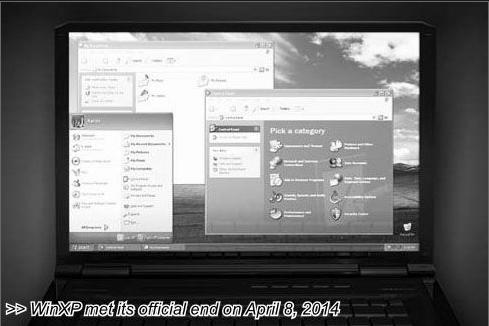WinXP No More
2014-09-22


In spite of the delay, here still came April 8, the day when Microsofts Windows XP retired. According to the news release from Microsoft, it officially stopped the tech support for Windows XP OS and Office 2003 software. This means that users that continue to use WinXP will be exposed to threats and cyberattacks they have never faced.
Microsoft attributes WinXPs retirement to the rise of mobile Internet and progress of Internet technologies, as well as the continuous development of new hardware technologies and products. All these have rendered WinXP, which is 13 years old, unable to keep up with the time. It is no longer able to meet the demand for working and entertainment in the new era. Nor is it able to resist the already-existing and always-upgrading cyberattack and online threats.
Microsofts PR team in China wrote in its official Microblog: “A thousandmile journey with your companion has met its end. Farewell, my friend. In spite of our 13-year friendship, it is time to move forward and embrace the future.”
Windows 8.1 on Promotional Sale
Why did Microsoft want to stop the support for WinXP and Office 2003? As it explained, in 2002, Microsoft introduced the lifecycle for its products based on the users response. According to this strategy, the products Microsoft developed, such as Windows OS and Office software, get at least ten-year support (five-year mainstream support and five-year extendable support) based on its service level.
“WinXP, born in 2001, has been working for 13 years. It is the longestserving operating system in humans history. However, with the development of technologies, WinXP is far from enough to satisfy the new requirements of modern working and entertainment brought by cloud computing, mobile Internet, social media and big data. It is unable to handle the current online threats either,”said Microsoft in a public letter.
The meaning of stopping the support for WinXP and Office 2003 means that Microsoft will no longer provide new safety upgrade, non-safety repair and upgrade, free or paid tech support and online content update.
The end of support does not meant that users can no longer use WinXP and Office 2003, but those that are still using them have to face potential risks.
The first risk is concerning the safety and compliance analysis. Without the official support, computers running with WinXP will be easily hacked by cyber-attackers. The second risk is the short supply of compatible hardware and software. Nowadays, many pieces of hardware and software have eliminated their compatibility with WinXP.endprint
As for the solutions, Microsoft advised the users to either “upgrade your computers operating system” or “buy a new computer”.
When Microsoft stopped its official support for WinXP, it puts more efforts in its Windows 8.1 operating system, which just came out five months before the retirement of its predecessor. As some analyst said, Microsoft will not throw too much energy in WinXP with three follow-up products at its heels(Windows Vista, Windows 7and Windows 8). The retirement of WinXP will be a promotional force to push Windows 8.1.
The latest data from NetApplications said that Microsoft took 90% of the PC operating market in March, much more than Apples 7.57% and Linuxs 1.49% market share. In the Microsofts family of products, Windows 7 took 48.77%; WinXP took 27.69% while Windows 8 and its upgraded version Windows 8.1 totally took 8.1% of the market.
In order to promote Windows 8.1 in China, Microsoft initiated a great discount to the new system. As of April 8, when WinXP officially retired, Chinese users could upgrade their operating system to Windows 8.1 with only 299 yuan, about 31% of its original price.
Huge Profits from Updating
Last year, Microsoft announced that users can upgrade its Windows 8 to Windows 8.1 without any additional payments. However, it the users are using WinXP, Windows Vista or Windows 7, they need to pay US$119.99 for upgrading to Windows 8.1 basic version or 199.99 for Windows 8.1 Prof. In addition, users also need to pay for using the legal version of Windows 8 operating system.
According to the data from CNNIC, 55.5% of the PCs used in offices in China are running with WinXP. 26.25% of these computers are installed with Windows 7 while only 5.57% are running with other operating systems. The popularity of WinXP is not abated in the household PCs of China, as 46.68% of the users are still using this operating system, higher than the proportions of users of Windows 7(40.58%) and other systems (5.33%).
Therefore, if those WinXP users need to upgrade their retired operating system, the sales of Microsoft will be massively increased in China.
According to Microsofts Q2 financial report published in January, the U.S. company had the sales revenue of US$24.519 billion, up 14% from the US$21.456-billion sales last year. The net profits amounted to US$6.558 billion, 3% higher than the net profits of US6.377 billion a year before. Amy Hood, CFO and executive vice president, said that the end of WinXP is one of the three reasons for the impressive improvement of Microsofts business.endprint
A Liyan, an analyst from CNNIC, said that WinXP is more widely used in offices than in houses in China. The organizational users, such as governmental departments and enterprises, usually tailored their office systems and other self-owned software for WinXP. It is undoubtedly a big challenge for them to change into the new operating system, since the re-design of other compatible apps will be a huge cost.
For the household users, however, the spending and unfamiliarity with the new operating system became the biggest hurdles for long-time WinXP users to embrace the new system. As the survey has unveiled, 22.56% of Chinese WinXP users thought it too costly to upgrade to Windows 8.1 and 21.82% fear that they do not know how to use this new operating system. According to A Liyan, it takes money and time to upgrade into the new operating system and get familiar with it. The changed compatibility and using habits will lead to an adaptive period with low efficiency.
The research of CNNIC also showed that only 25.06% of Chinese WinXP users are willing to upgrade their original system into the new one. 5.76% of the respondents, however, considered the “end of support for WinXP” to be their best reason to buy a new computer. But more than half of the household users in China said that they would continue to use WinXP till it is no longer working.
Internet Safety Companies on Move
Chinese users reluctance to abandon WinXP might be good news for the Internet safety companies in China.
They have already been on the move. When Microsoft announced the plan of having WinXP retire, Qihu 360, Tecent, Baidu, Kingsoft and Rising all announced their plans and aspirations to protect the WinXP users.
On March 7, Microsoft united with Tecent and Kingsoft to launch the“support plan for WinXP users”. Ding Ke, vice president of Tecent, said that the company had launched a series of products to prevent WinXP users from the defects and cyber-attacks. In addition, they could help to consolidate and repair the soft spots of WinXP.
Later, Baidu and other companies became the agents of Microsoft in China to protect the WinXP. Even CNNIC, a state-owned organization, established an online platform, allowing users to check about their safety and download debugged software.
However, as Microsoft stated, “any protection measure has its own defect and shortage. The best way to rid of the problems is still to upgrade into the new system”.endprint
Those potential problems could not prevent the Internet safety companies in China from exploring the huge market left by the retired WinXP. There are still 350 million users in China running WinXP and about 200 million do not want to change at least for a while. How to protect the safety of these peoples safety is a great task, and a great opportunity for the awaiting Internet safety companies in China.
History of WinXP
WinXP was launched in October 25, 2001. It was the first operating system Microsoft launched for PC users. XP here comes from Experience. It is also the first operating stem based on Microsofts Windows NT structure.
WinXP came out with two versions: Prof and Household. Later it was adopted to the tablet, embedded version and client end.
On September 9, 2002, Microsoft launched the first service pack for WinXP.
In January 2008, WinXPs global market share reached higher than 76%, the highest in the history that no other operating systems have ever achieved.
On April 19, 2009, the support for WinXP entered the period of extendable support, meaning that Microsoft will stop providing free tech support and warranty support but still supply monthly upgrade for safety issues on a monthly basis.endprint
